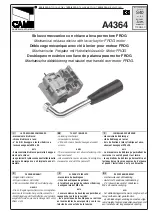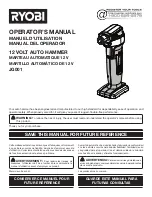
408- 8678
Rev
C
2
of 6
Figure 2
Upper Die
Lower Die
Indenters
Anvils
Die Retaining
Screws
Stationary Jaw
Reasons for revision are given in Section 9,
REVISION SUMMARY.
2. DESCRIPTION
(Figures 1 and 2)
The tool features a tool frame with a stationary jaw
and handle, a moving jaw, a moving handle, and an
adjustable ratchet that ensures full crimping.
The tool frame holds a die assembly with three
crimping chambers. The die assembly features an
upper die and a lower die. Die retaining screws are
used to position and secure the dies in the tool frame.
3. DIE ASSEMBLY INSTALLATION AND REMOVAL
1. Open the tool handles and remove the two die
retaining screws from the tool jaws.
2. Place the upper die in the stationary jaw of the
tool frame so that the largest indenter is facing
inward. See Figure 2.
3. Insert the die retaining screw through the
stationary jaw and through the die. Tighten the
screw just enough to hold the die in place. Do
not
tighten the screw completely at this time.
4. Place the lower die in the moving jaw of the tool
frame so that the largest anvil is facing inward. See
Figure 2.
5. Insert the die retaining screw through the
moving jaw and through the die. Tighten the screw
just enough to hold the die in place. Do
not
tighten
the screw completely at this time.
6. Carefully close the tool handles, making sure
that the anvils and indenters align properly.
Continue closing the tool handles until the ratchet
has engaged sufficiently to hold the dies in place,
then tighten both die retaining screws.
7. To disassemble, open the tool handles until the
ratchet releases, remove the two die retaining
screws, and slide the dies out of the tool jaws.
4. CRIMPING PROCEDURE
Before using the tool, the crimping chambers and
tool ratchet should be inspected as specified in
Section 5, CRIMP HEIGHT INSPECTION, and
Section 6, RATCHET (Shut Height)
ADJUSTMENT.
Refer to Figure 1 and select wire of the specified size
and insulation diameter. Strip the wire to the length
indicated, taking care not to nick or cut wire strands.
Select an applicable terminal or splice and identify the
appropriate crimping chamber according to the wire
size markings on the dies. Refer to Figure 3 and
proceed as follows:
The crimping chamber marked “12--10” cannot be
used to crimp spade--type terminals.
1. Hold tool so that the back (wire side) is facing
you. Squeeze tool handles together until the
ratchet releases, then allow them to open fully.
NOTE
i
NOTE
i
























